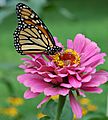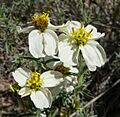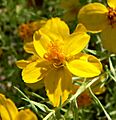Zinnia facts for kids
Quick facts for kids Zinnia |
|
|---|---|
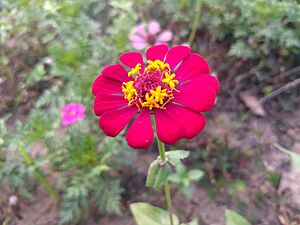 |
|
| Zinnia flower | |
| Scientific classification |
|
| Kingdom: | Plantae |
| Clade: | Tracheophytes |
| Clade: | Angiosperms |
| Clade: | Eudicots |
| Clade: | Asterids |
| Order: | Asterales |
| Family: | Asteraceae |
| Subfamily: | Asteroideae |
| Supertribe: | Helianthodae |
| Tribe: | Heliantheae |
| Genus: | Zinnia L. |
| Type species | |
| Chrysogonum peruvianum |
|
| Synonyms | |
|
|
Zinnias are beautiful flowering plants known for their bright, colorful blooms. They belong to a plant family called Asteraceae, which also includes daisies and sunflowers. These cheerful flowers originally grew in dry, open areas from the Southwestern United States all the way down to South America, with many different kinds found in Mexico. Zinnias are famous for their single flowers, each on a long stem, with many petals that come in almost every color of the rainbow! The name Zinnia was given to honor a German scientist named Johann Gottfried Zinn.
Contents
Discovering Zinnias
What Do Zinnias Look Like?
Zinnias can be different types of plants: some grow for just one year (called annuals), while others are small bushes (shrubs) or even smaller, woody plants (sub-shrubs). Most zinnias grow straight up, but some spread out along the ground. They can be anywhere from 10 to 100 centimeters (about 4 to 40 inches) tall.
Their leaves grow in pairs on opposite sides of the stem and usually don't have stalks. The leaves can be long and thin or more oval-shaped, and they are typically a light to medium green color.
Zinnia flowers are quite special! They are actually made up of many tiny flowers grouped together, called a composite flower. You'll see colorful "petals" around the outside, which are called ray florets. In the center, there are smaller disk florets, which can sometimes be a different color. Zinnia flowers come in many shapes, from a simple single row of petals to a full, dome-like bloom. You can find zinnias in white, yellow, orange, red, purple, pink, and even a greenish-yellow color called chartreuse!
Growing Your Own Zinnias
Zinnias are a great choice for gardeners because they are quite easy to grow and produce lots of bright, colorful flowers! Their petals can look different:
- Single-flowered zinnias have one row of petals with a clear center.
- Double-flowered zinnias have many rows of petals, making the center hard to see.
- Semi-double-flowered zinnias are in-between, with many rows of petals but still a visible center.
These plants are usually grown directly from seeds planted in the ground, which is called growing them in situ. This is because zinnias don't like to be moved once they start growing. Like many other sunny flowers, they love lots of sunlight and enough water. If they get what they need, they will grow fast! However, zinnias don't like cold weather and will die when the first frost of autumn arrives.
To help your zinnias produce even more flowers, you can "deadhead" them. This means carefully removing the faded or spent blooms. It encourages the plant to put its energy into making new flowers instead of seeds.
Types of Zinnias
There are many different kinds of zinnias, each with its own unique look! Most zinnias come from North and South America, especially Mexico.
Famous Zinnia Species
One of the most well-known types is Zinnia elegans, sometimes called Zinnia violacea. This species originally comes from the warm parts of Mexico. Its leaves feel a bit like sandpaper and are shaped like a spear. These plants can grow from 15 centimeters (6 inches) to a full meter (about 3 feet) tall!
Another popular Mexican species is Zinnia angustifolia. This zinnia grows in a low, bushy shape with thinner leaves. Its flowers are usually single, meaning they have one row of petals, and come in shades of yellow, orange, or white. Zinnia angustifolia is also stronger against a plant disease called powdery mildew. Scientists have even created new types of zinnias by mixing Z. elegans and Z. angustifolia to get the best features of both!
Zinnias are also a favorite for many creatures! Butterflies and hummingbirds love to visit zinnia flowers. Many gardeners plant zinnias just to attract these beautiful visitors to their gardens.
-
A Hummingbird hawk-moth enjoying a flower.
-
A Vanessa cardui butterfly.
-
The striking Vanessa atalanta butterfly.
-
A Monarch butterfly resting on a pink zinnia.
Why Are Zinnias Special?
Zinnias are very popular garden flowers for many reasons. They offer a huge variety of colors and shapes, can handle hot summer weather, and are simple to grow from seeds. They bloom all summer long, bringing cheer to any garden! Zinnias grow best in sunny spots with rich, well-drained soil. They can even drop their own seeds and grow again the next year.
People have been working to create new and exciting types of zinnias for a long time. Since the 1800s, over 100 different cultivars (special varieties created by humans) have been developed!
The Zinnia peruviana was first brought to Europe in the early 1700s. Later, around 1790, Zinnia elegans (also known as Zinnia violacea) arrived. These early plants had single, violet-colored petals. Over time, new colors like scarlet appeared, and by 1858, zinnias with many rows of petals (double flowers) were available in a rainbow of colors! In the past, zinnias were sometimes used in the "language of flowers" to mean "thinking of absent friends."
Today, many different kinds of zinnias are grown, including special hybrids that combine the best traits of different species. Their varied sizes and shapes mean they can fit into many parts of a garden. Plus, their ability to attract butterflies and hummingbirds makes them even more desirable!
Some types of zinnias can even be eaten, though they often taste a bit bitter. They are usually used as a colorful garnish to make food look pretty.
Zinnias in Space!
Did you know zinnias have been to space? Scientists on the International Space Station (ISS) conducted experiments that showed zinnias can grow and bloom even in a weightless environment! This was an exciting discovery, proving that these cheerful flowers can be part of plants in space and perhaps even help future astronauts grow food or simply enjoy some beauty far from Earth.
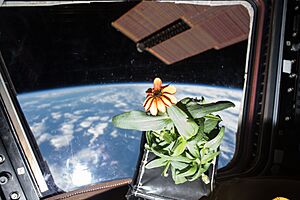
Zinnia Friends in the Garden
Zinnias are not just pretty; they can also be helpful in the garden! In some parts of the Americas, their ability to attract hummingbirds is useful because hummingbirds can help keep away tiny pests called whiteflies. Because of this, zinnias are considered a good "companion plant." When planted near other vegetables or flowers, they can help protect them, making them a great addition to a garden that uses inter-cropping (planting different crops together).
Zinnia Pictures
Here are some more beautiful pictures of zinnias!
See Also
- Arthur B. Howard







